Corruption in Nepal: Examining Forms, Causes, and Government Actions
VerifiedAdded on 2023/04/23
|8
|2147
|104
Essay
AI Summary
This essay provides a comprehensive analysis of corruption in Nepal, highlighting its various forms such as bribery, embezzlement, fraud, extortion, and favouritism. It discusses the causes of corruption, including political instability, lack of accountability and transparency, and inadequate public awareness. The essay also examines the strategies implemented by the Nepalese government to minimize corruption, such as the 'Prevention of Corruption Act' and the DFID's Anti-Corruption Strategy. The author concludes that addressing corruption requires prioritizing both legally and socially sanctioned spheres, promoting political and economic competition, and fostering accountability and transparency within the government and civil society. This analysis emphasizes the detrimental impact of corruption on Nepal's business competitiveness, economic costs, and the quality of public services.
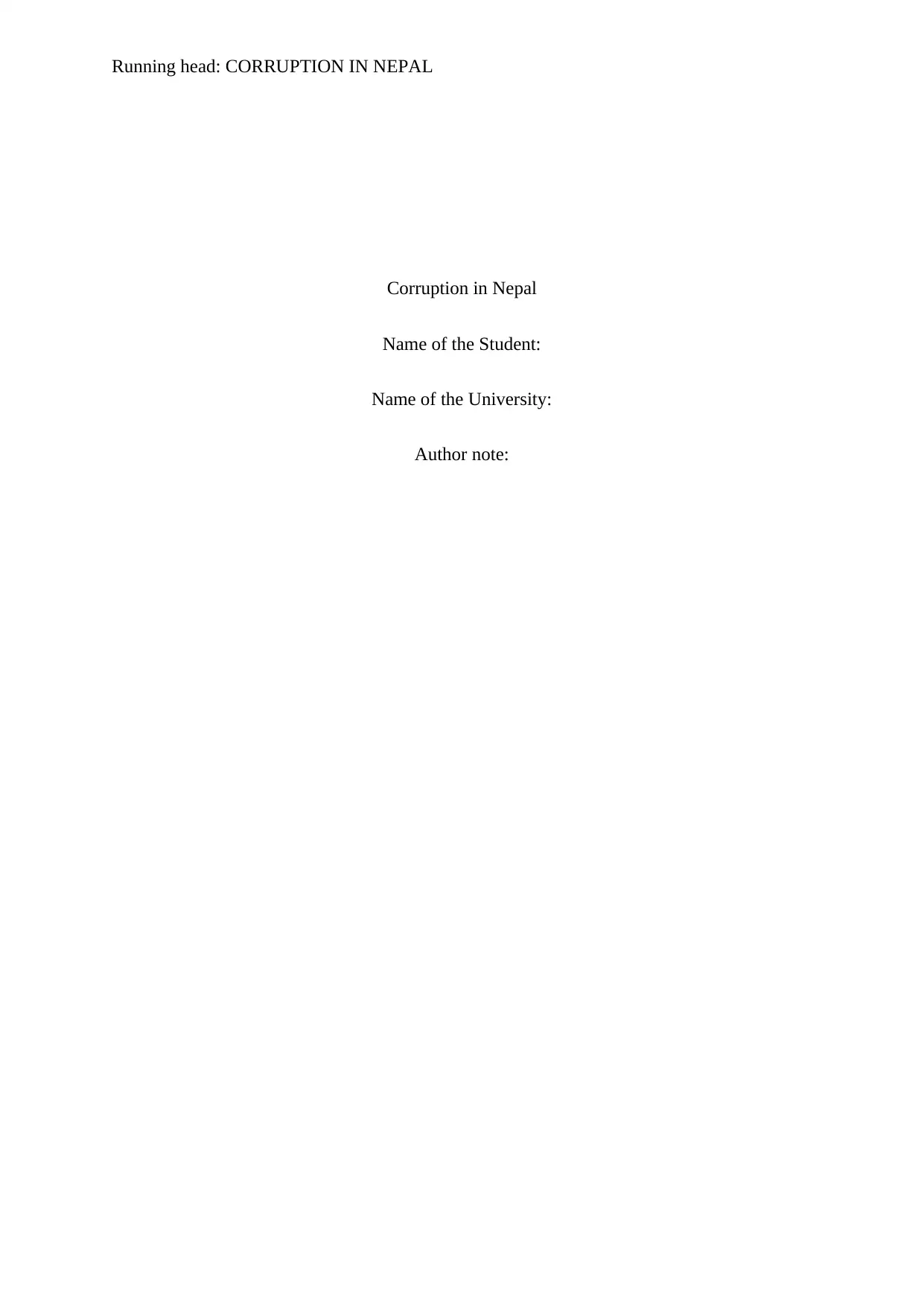
Running head: CORRUPTION IN NEPAL
Corruption in Nepal
Name of the Student:
Name of the University:
Author note:
Corruption in Nepal
Name of the Student:
Name of the University:
Author note:
Paraphrase This Document
Need a fresh take? Get an instant paraphrase of this document with our AI Paraphraser
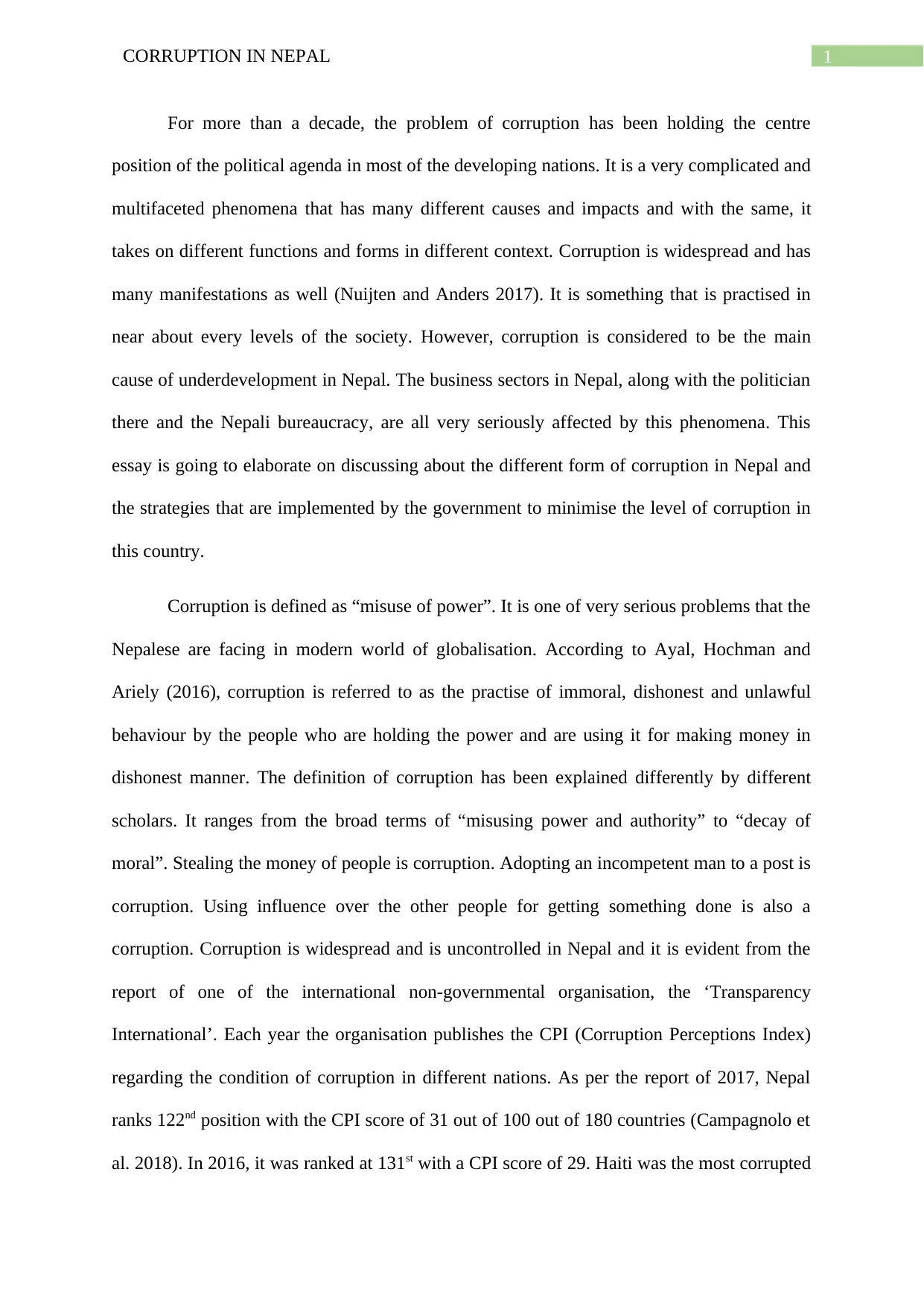
1CORRUPTION IN NEPAL
For more than a decade, the problem of corruption has been holding the centre
position of the political agenda in most of the developing nations. It is a very complicated and
multifaceted phenomena that has many different causes and impacts and with the same, it
takes on different functions and forms in different context. Corruption is widespread and has
many manifestations as well (Nuijten and Anders 2017). It is something that is practised in
near about every levels of the society. However, corruption is considered to be the main
cause of underdevelopment in Nepal. The business sectors in Nepal, along with the politician
there and the Nepali bureaucracy, are all very seriously affected by this phenomena. This
essay is going to elaborate on discussing about the different form of corruption in Nepal and
the strategies that are implemented by the government to minimise the level of corruption in
this country.
Corruption is defined as “misuse of power”. It is one of very serious problems that the
Nepalese are facing in modern world of globalisation. According to Ayal, Hochman and
Ariely (2016), corruption is referred to as the practise of immoral, dishonest and unlawful
behaviour by the people who are holding the power and are using it for making money in
dishonest manner. The definition of corruption has been explained differently by different
scholars. It ranges from the broad terms of “misusing power and authority” to “decay of
moral”. Stealing the money of people is corruption. Adopting an incompetent man to a post is
corruption. Using influence over the other people for getting something done is also a
corruption. Corruption is widespread and is uncontrolled in Nepal and it is evident from the
report of one of the international non-governmental organisation, the ‘Transparency
International’. Each year the organisation publishes the CPI (Corruption Perceptions Index)
regarding the condition of corruption in different nations. As per the report of 2017, Nepal
ranks 122nd position with the CPI score of 31 out of 100 out of 180 countries (Campagnolo et
al. 2018). In 2016, it was ranked at 131st with a CPI score of 29. Haiti was the most corrupted
For more than a decade, the problem of corruption has been holding the centre
position of the political agenda in most of the developing nations. It is a very complicated and
multifaceted phenomena that has many different causes and impacts and with the same, it
takes on different functions and forms in different context. Corruption is widespread and has
many manifestations as well (Nuijten and Anders 2017). It is something that is practised in
near about every levels of the society. However, corruption is considered to be the main
cause of underdevelopment in Nepal. The business sectors in Nepal, along with the politician
there and the Nepali bureaucracy, are all very seriously affected by this phenomena. This
essay is going to elaborate on discussing about the different form of corruption in Nepal and
the strategies that are implemented by the government to minimise the level of corruption in
this country.
Corruption is defined as “misuse of power”. It is one of very serious problems that the
Nepalese are facing in modern world of globalisation. According to Ayal, Hochman and
Ariely (2016), corruption is referred to as the practise of immoral, dishonest and unlawful
behaviour by the people who are holding the power and are using it for making money in
dishonest manner. The definition of corruption has been explained differently by different
scholars. It ranges from the broad terms of “misusing power and authority” to “decay of
moral”. Stealing the money of people is corruption. Adopting an incompetent man to a post is
corruption. Using influence over the other people for getting something done is also a
corruption. Corruption is widespread and is uncontrolled in Nepal and it is evident from the
report of one of the international non-governmental organisation, the ‘Transparency
International’. Each year the organisation publishes the CPI (Corruption Perceptions Index)
regarding the condition of corruption in different nations. As per the report of 2017, Nepal
ranks 122nd position with the CPI score of 31 out of 100 out of 180 countries (Campagnolo et
al. 2018). In 2016, it was ranked at 131st with a CPI score of 29. Haiti was the most corrupted
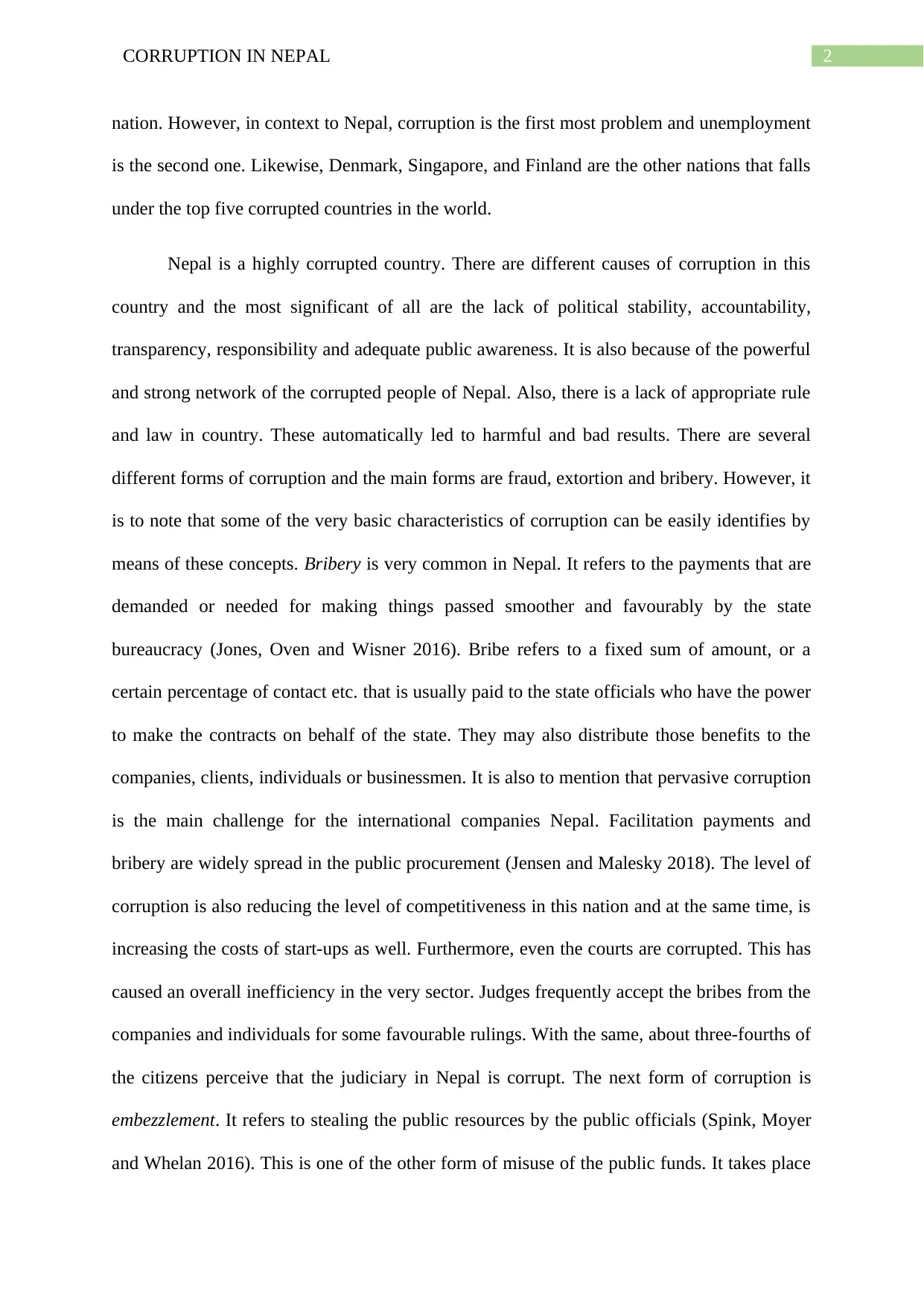
2CORRUPTION IN NEPAL
nation. However, in context to Nepal, corruption is the first most problem and unemployment
is the second one. Likewise, Denmark, Singapore, and Finland are the other nations that falls
under the top five corrupted countries in the world.
Nepal is a highly corrupted country. There are different causes of corruption in this
country and the most significant of all are the lack of political stability, accountability,
transparency, responsibility and adequate public awareness. It is also because of the powerful
and strong network of the corrupted people of Nepal. Also, there is a lack of appropriate rule
and law in country. These automatically led to harmful and bad results. There are several
different forms of corruption and the main forms are fraud, extortion and bribery. However, it
is to note that some of the very basic characteristics of corruption can be easily identifies by
means of these concepts. Bribery is very common in Nepal. It refers to the payments that are
demanded or needed for making things passed smoother and favourably by the state
bureaucracy (Jones, Oven and Wisner 2016). Bribe refers to a fixed sum of amount, or a
certain percentage of contact etc. that is usually paid to the state officials who have the power
to make the contracts on behalf of the state. They may also distribute those benefits to the
companies, clients, individuals or businessmen. It is also to mention that pervasive corruption
is the main challenge for the international companies Nepal. Facilitation payments and
bribery are widely spread in the public procurement (Jensen and Malesky 2018). The level of
corruption is also reducing the level of competitiveness in this nation and at the same time, is
increasing the costs of start-ups as well. Furthermore, even the courts are corrupted. This has
caused an overall inefficiency in the very sector. Judges frequently accept the bribes from the
companies and individuals for some favourable rulings. With the same, about three-fourths of
the citizens perceive that the judiciary in Nepal is corrupt. The next form of corruption is
embezzlement. It refers to stealing the public resources by the public officials (Spink, Moyer
and Whelan 2016). This is one of the other form of misuse of the public funds. It takes place
nation. However, in context to Nepal, corruption is the first most problem and unemployment
is the second one. Likewise, Denmark, Singapore, and Finland are the other nations that falls
under the top five corrupted countries in the world.
Nepal is a highly corrupted country. There are different causes of corruption in this
country and the most significant of all are the lack of political stability, accountability,
transparency, responsibility and adequate public awareness. It is also because of the powerful
and strong network of the corrupted people of Nepal. Also, there is a lack of appropriate rule
and law in country. These automatically led to harmful and bad results. There are several
different forms of corruption and the main forms are fraud, extortion and bribery. However, it
is to note that some of the very basic characteristics of corruption can be easily identifies by
means of these concepts. Bribery is very common in Nepal. It refers to the payments that are
demanded or needed for making things passed smoother and favourably by the state
bureaucracy (Jones, Oven and Wisner 2016). Bribe refers to a fixed sum of amount, or a
certain percentage of contact etc. that is usually paid to the state officials who have the power
to make the contracts on behalf of the state. They may also distribute those benefits to the
companies, clients, individuals or businessmen. It is also to mention that pervasive corruption
is the main challenge for the international companies Nepal. Facilitation payments and
bribery are widely spread in the public procurement (Jensen and Malesky 2018). The level of
corruption is also reducing the level of competitiveness in this nation and at the same time, is
increasing the costs of start-ups as well. Furthermore, even the courts are corrupted. This has
caused an overall inefficiency in the very sector. Judges frequently accept the bribes from the
companies and individuals for some favourable rulings. With the same, about three-fourths of
the citizens perceive that the judiciary in Nepal is corrupt. The next form of corruption is
embezzlement. It refers to stealing the public resources by the public officials (Spink, Moyer
and Whelan 2016). This is one of the other form of misuse of the public funds. It takes place
⊘ This is a preview!⊘
Do you want full access?
Subscribe today to unlock all pages.

Trusted by 1+ million students worldwide
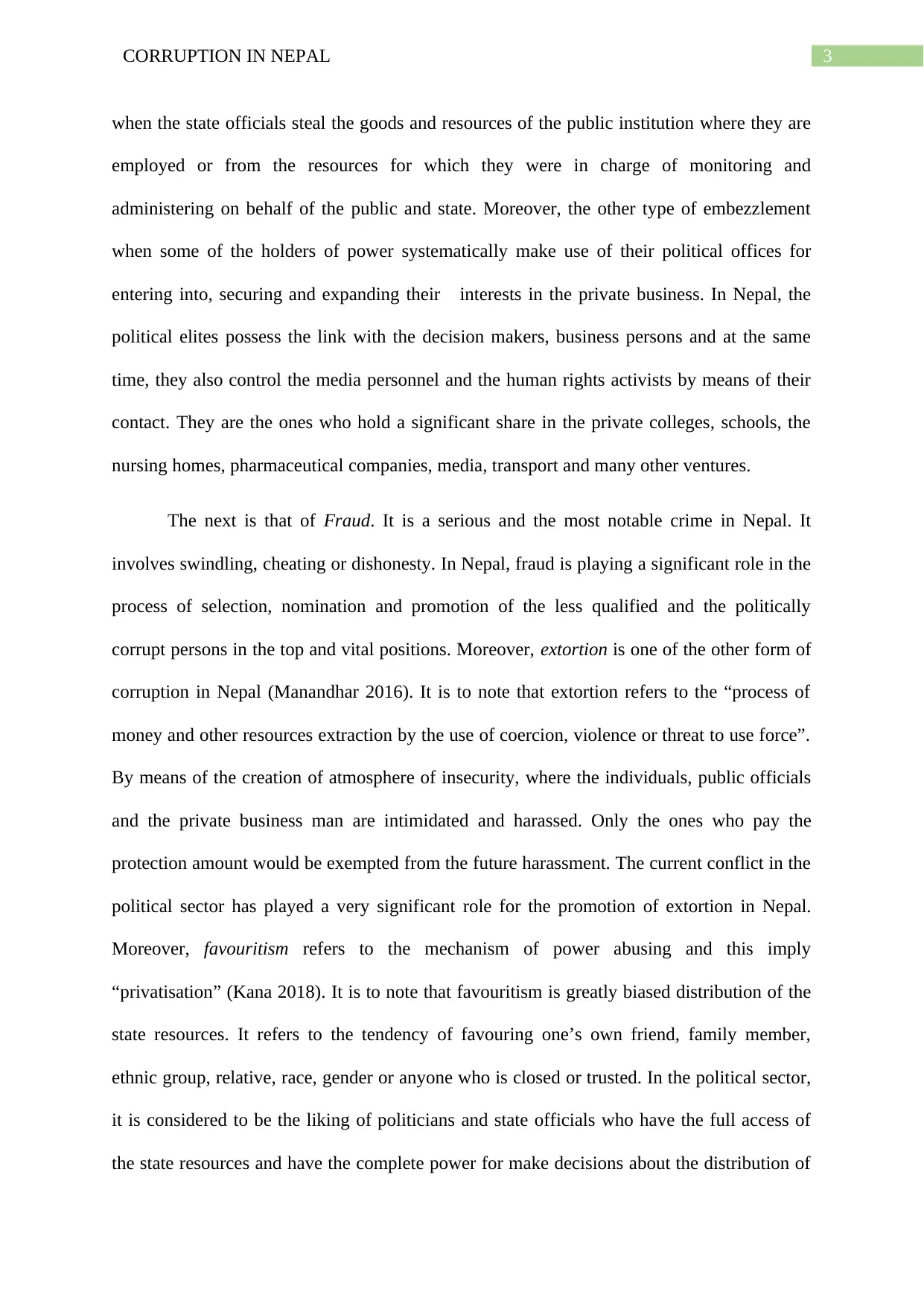
3CORRUPTION IN NEPAL
when the state officials steal the goods and resources of the public institution where they are
employed or from the resources for which they were in charge of monitoring and
administering on behalf of the public and state. Moreover, the other type of embezzlement
when some of the holders of power systematically make use of their political offices for
entering into, securing and expanding their interests in the private business. In Nepal, the
political elites possess the link with the decision makers, business persons and at the same
time, they also control the media personnel and the human rights activists by means of their
contact. They are the ones who hold a significant share in the private colleges, schools, the
nursing homes, pharmaceutical companies, media, transport and many other ventures.
The next is that of Fraud. It is a serious and the most notable crime in Nepal. It
involves swindling, cheating or dishonesty. In Nepal, fraud is playing a significant role in the
process of selection, nomination and promotion of the less qualified and the politically
corrupt persons in the top and vital positions. Moreover, extortion is one of the other form of
corruption in Nepal (Manandhar 2016). It is to note that extortion refers to the “process of
money and other resources extraction by the use of coercion, violence or threat to use force”.
By means of the creation of atmosphere of insecurity, where the individuals, public officials
and the private business man are intimidated and harassed. Only the ones who pay the
protection amount would be exempted from the future harassment. The current conflict in the
political sector has played a very significant role for the promotion of extortion in Nepal.
Moreover, favouritism refers to the mechanism of power abusing and this imply
“privatisation” (Kana 2018). It is to note that favouritism is greatly biased distribution of the
state resources. It refers to the tendency of favouring one’s own friend, family member,
ethnic group, relative, race, gender or anyone who is closed or trusted. In the political sector,
it is considered to be the liking of politicians and state officials who have the full access of
the state resources and have the complete power for make decisions about the distribution of
when the state officials steal the goods and resources of the public institution where they are
employed or from the resources for which they were in charge of monitoring and
administering on behalf of the public and state. Moreover, the other type of embezzlement
when some of the holders of power systematically make use of their political offices for
entering into, securing and expanding their interests in the private business. In Nepal, the
political elites possess the link with the decision makers, business persons and at the same
time, they also control the media personnel and the human rights activists by means of their
contact. They are the ones who hold a significant share in the private colleges, schools, the
nursing homes, pharmaceutical companies, media, transport and many other ventures.
The next is that of Fraud. It is a serious and the most notable crime in Nepal. It
involves swindling, cheating or dishonesty. In Nepal, fraud is playing a significant role in the
process of selection, nomination and promotion of the less qualified and the politically
corrupt persons in the top and vital positions. Moreover, extortion is one of the other form of
corruption in Nepal (Manandhar 2016). It is to note that extortion refers to the “process of
money and other resources extraction by the use of coercion, violence or threat to use force”.
By means of the creation of atmosphere of insecurity, where the individuals, public officials
and the private business man are intimidated and harassed. Only the ones who pay the
protection amount would be exempted from the future harassment. The current conflict in the
political sector has played a very significant role for the promotion of extortion in Nepal.
Moreover, favouritism refers to the mechanism of power abusing and this imply
“privatisation” (Kana 2018). It is to note that favouritism is greatly biased distribution of the
state resources. It refers to the tendency of favouring one’s own friend, family member,
ethnic group, relative, race, gender or anyone who is closed or trusted. In the political sector,
it is considered to be the liking of politicians and state officials who have the full access of
the state resources and have the complete power for make decisions about the distribution of
Paraphrase This Document
Need a fresh take? Get an instant paraphrase of this document with our AI Paraphraser
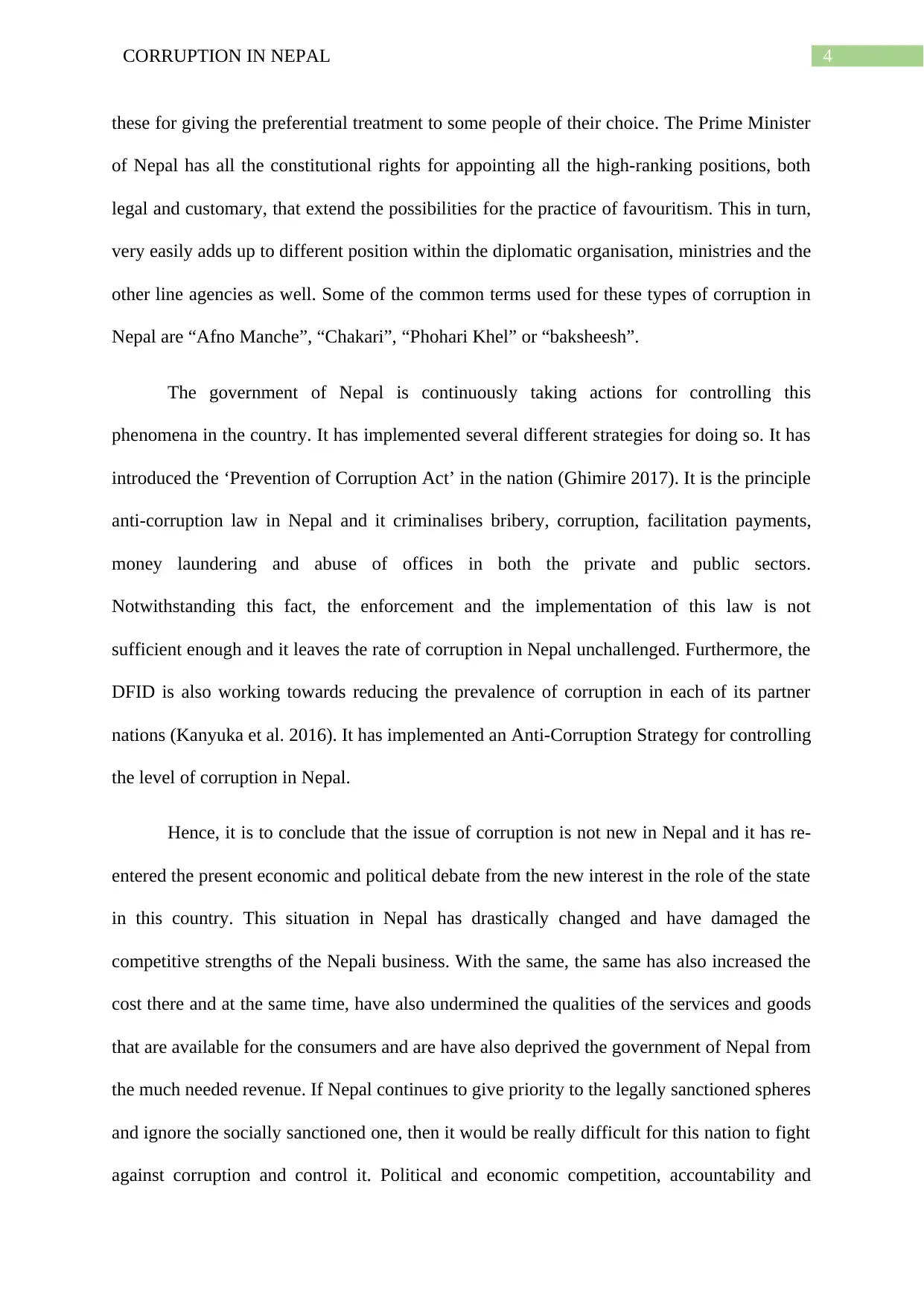
4CORRUPTION IN NEPAL
these for giving the preferential treatment to some people of their choice. The Prime Minister
of Nepal has all the constitutional rights for appointing all the high-ranking positions, both
legal and customary, that extend the possibilities for the practice of favouritism. This in turn,
very easily adds up to different position within the diplomatic organisation, ministries and the
other line agencies as well. Some of the common terms used for these types of corruption in
Nepal are “Afno Manche”, “Chakari”, “Phohari Khel” or “baksheesh”.
The government of Nepal is continuously taking actions for controlling this
phenomena in the country. It has implemented several different strategies for doing so. It has
introduced the ‘Prevention of Corruption Act’ in the nation (Ghimire 2017). It is the principle
anti-corruption law in Nepal and it criminalises bribery, corruption, facilitation payments,
money laundering and abuse of offices in both the private and public sectors.
Notwithstanding this fact, the enforcement and the implementation of this law is not
sufficient enough and it leaves the rate of corruption in Nepal unchallenged. Furthermore, the
DFID is also working towards reducing the prevalence of corruption in each of its partner
nations (Kanyuka et al. 2016). It has implemented an Anti-Corruption Strategy for controlling
the level of corruption in Nepal.
Hence, it is to conclude that the issue of corruption is not new in Nepal and it has re-
entered the present economic and political debate from the new interest in the role of the state
in this country. This situation in Nepal has drastically changed and have damaged the
competitive strengths of the Nepali business. With the same, the same has also increased the
cost there and at the same time, have also undermined the qualities of the services and goods
that are available for the consumers and are have also deprived the government of Nepal from
the much needed revenue. If Nepal continues to give priority to the legally sanctioned spheres
and ignore the socially sanctioned one, then it would be really difficult for this nation to fight
against corruption and control it. Political and economic competition, accountability and
these for giving the preferential treatment to some people of their choice. The Prime Minister
of Nepal has all the constitutional rights for appointing all the high-ranking positions, both
legal and customary, that extend the possibilities for the practice of favouritism. This in turn,
very easily adds up to different position within the diplomatic organisation, ministries and the
other line agencies as well. Some of the common terms used for these types of corruption in
Nepal are “Afno Manche”, “Chakari”, “Phohari Khel” or “baksheesh”.
The government of Nepal is continuously taking actions for controlling this
phenomena in the country. It has implemented several different strategies for doing so. It has
introduced the ‘Prevention of Corruption Act’ in the nation (Ghimire 2017). It is the principle
anti-corruption law in Nepal and it criminalises bribery, corruption, facilitation payments,
money laundering and abuse of offices in both the private and public sectors.
Notwithstanding this fact, the enforcement and the implementation of this law is not
sufficient enough and it leaves the rate of corruption in Nepal unchallenged. Furthermore, the
DFID is also working towards reducing the prevalence of corruption in each of its partner
nations (Kanyuka et al. 2016). It has implemented an Anti-Corruption Strategy for controlling
the level of corruption in Nepal.
Hence, it is to conclude that the issue of corruption is not new in Nepal and it has re-
entered the present economic and political debate from the new interest in the role of the state
in this country. This situation in Nepal has drastically changed and have damaged the
competitive strengths of the Nepali business. With the same, the same has also increased the
cost there and at the same time, have also undermined the qualities of the services and goods
that are available for the consumers and are have also deprived the government of Nepal from
the much needed revenue. If Nepal continues to give priority to the legally sanctioned spheres
and ignore the socially sanctioned one, then it would be really difficult for this nation to fight
against corruption and control it. Political and economic competition, accountability and
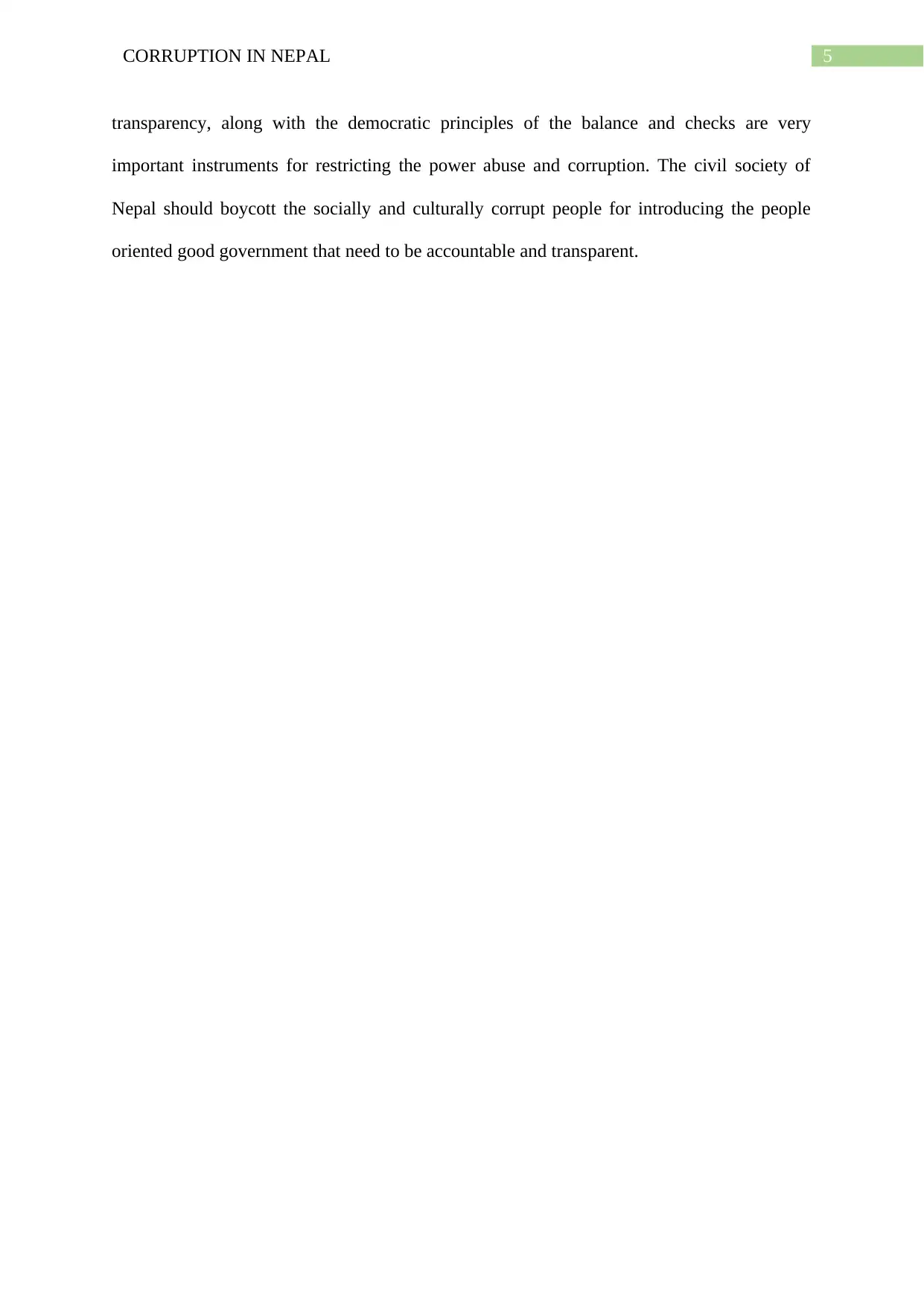
5CORRUPTION IN NEPAL
transparency, along with the democratic principles of the balance and checks are very
important instruments for restricting the power abuse and corruption. The civil society of
Nepal should boycott the socially and culturally corrupt people for introducing the people
oriented good government that need to be accountable and transparent.
transparency, along with the democratic principles of the balance and checks are very
important instruments for restricting the power abuse and corruption. The civil society of
Nepal should boycott the socially and culturally corrupt people for introducing the people
oriented good government that need to be accountable and transparent.
⊘ This is a preview!⊘
Do you want full access?
Subscribe today to unlock all pages.

Trusted by 1+ million students worldwide
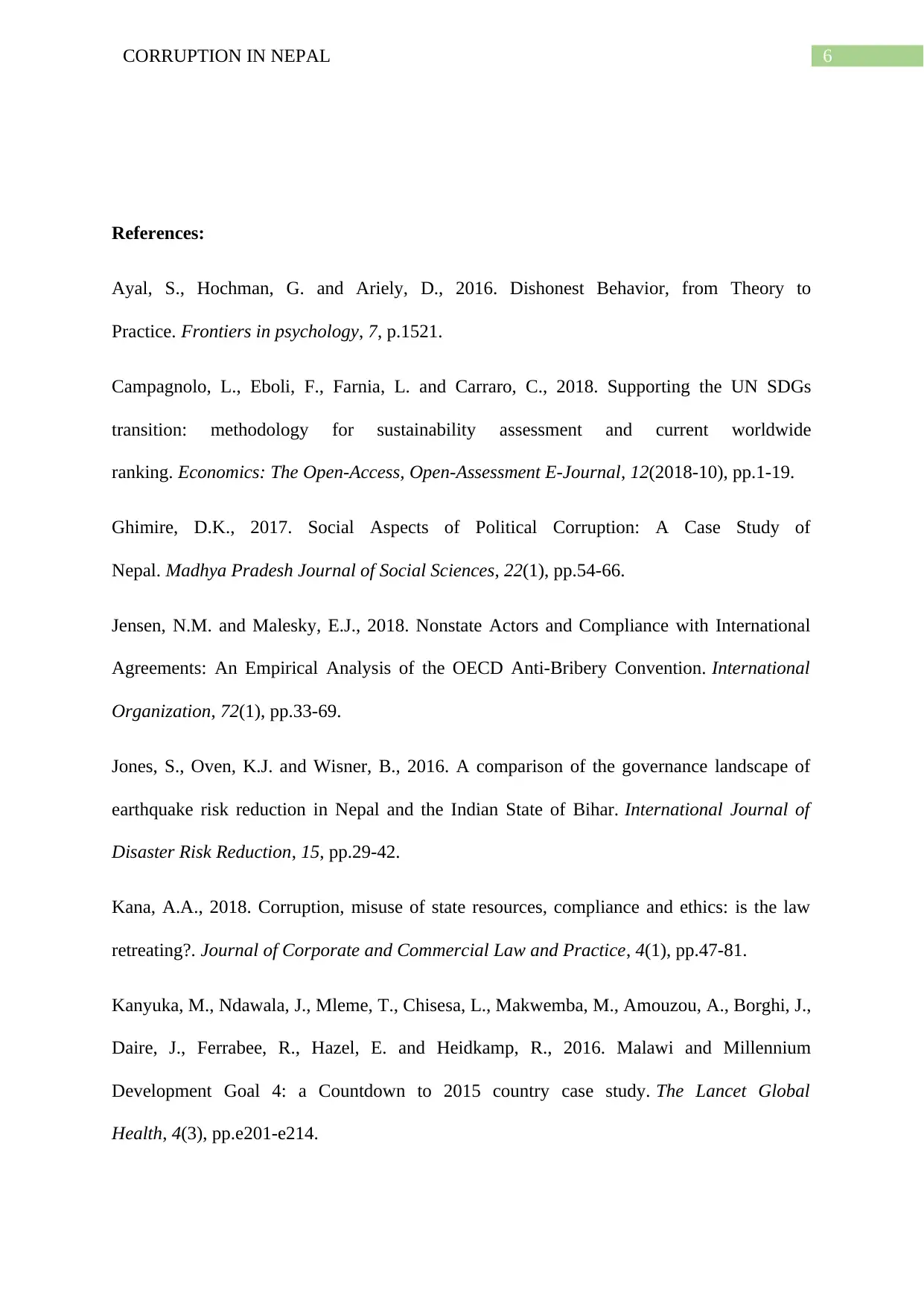
6CORRUPTION IN NEPAL
References:
Ayal, S., Hochman, G. and Ariely, D., 2016. Dishonest Behavior, from Theory to
Practice. Frontiers in psychology, 7, p.1521.
Campagnolo, L., Eboli, F., Farnia, L. and Carraro, C., 2018. Supporting the UN SDGs
transition: methodology for sustainability assessment and current worldwide
ranking. Economics: The Open-Access, Open-Assessment E-Journal, 12(2018-10), pp.1-19.
Ghimire, D.K., 2017. Social Aspects of Political Corruption: A Case Study of
Nepal. Madhya Pradesh Journal of Social Sciences, 22(1), pp.54-66.
Jensen, N.M. and Malesky, E.J., 2018. Nonstate Actors and Compliance with International
Agreements: An Empirical Analysis of the OECD Anti-Bribery Convention. International
Organization, 72(1), pp.33-69.
Jones, S., Oven, K.J. and Wisner, B., 2016. A comparison of the governance landscape of
earthquake risk reduction in Nepal and the Indian State of Bihar. International Journal of
Disaster Risk Reduction, 15, pp.29-42.
Kana, A.A., 2018. Corruption, misuse of state resources, compliance and ethics: is the law
retreating?. Journal of Corporate and Commercial Law and Practice, 4(1), pp.47-81.
Kanyuka, M., Ndawala, J., Mleme, T., Chisesa, L., Makwemba, M., Amouzou, A., Borghi, J.,
Daire, J., Ferrabee, R., Hazel, E. and Heidkamp, R., 2016. Malawi and Millennium
Development Goal 4: a Countdown to 2015 country case study. The Lancet Global
Health, 4(3), pp.e201-e214.
References:
Ayal, S., Hochman, G. and Ariely, D., 2016. Dishonest Behavior, from Theory to
Practice. Frontiers in psychology, 7, p.1521.
Campagnolo, L., Eboli, F., Farnia, L. and Carraro, C., 2018. Supporting the UN SDGs
transition: methodology for sustainability assessment and current worldwide
ranking. Economics: The Open-Access, Open-Assessment E-Journal, 12(2018-10), pp.1-19.
Ghimire, D.K., 2017. Social Aspects of Political Corruption: A Case Study of
Nepal. Madhya Pradesh Journal of Social Sciences, 22(1), pp.54-66.
Jensen, N.M. and Malesky, E.J., 2018. Nonstate Actors and Compliance with International
Agreements: An Empirical Analysis of the OECD Anti-Bribery Convention. International
Organization, 72(1), pp.33-69.
Jones, S., Oven, K.J. and Wisner, B., 2016. A comparison of the governance landscape of
earthquake risk reduction in Nepal and the Indian State of Bihar. International Journal of
Disaster Risk Reduction, 15, pp.29-42.
Kana, A.A., 2018. Corruption, misuse of state resources, compliance and ethics: is the law
retreating?. Journal of Corporate and Commercial Law and Practice, 4(1), pp.47-81.
Kanyuka, M., Ndawala, J., Mleme, T., Chisesa, L., Makwemba, M., Amouzou, A., Borghi, J.,
Daire, J., Ferrabee, R., Hazel, E. and Heidkamp, R., 2016. Malawi and Millennium
Development Goal 4: a Countdown to 2015 country case study. The Lancet Global
Health, 4(3), pp.e201-e214.
Paraphrase This Document
Need a fresh take? Get an instant paraphrase of this document with our AI Paraphraser
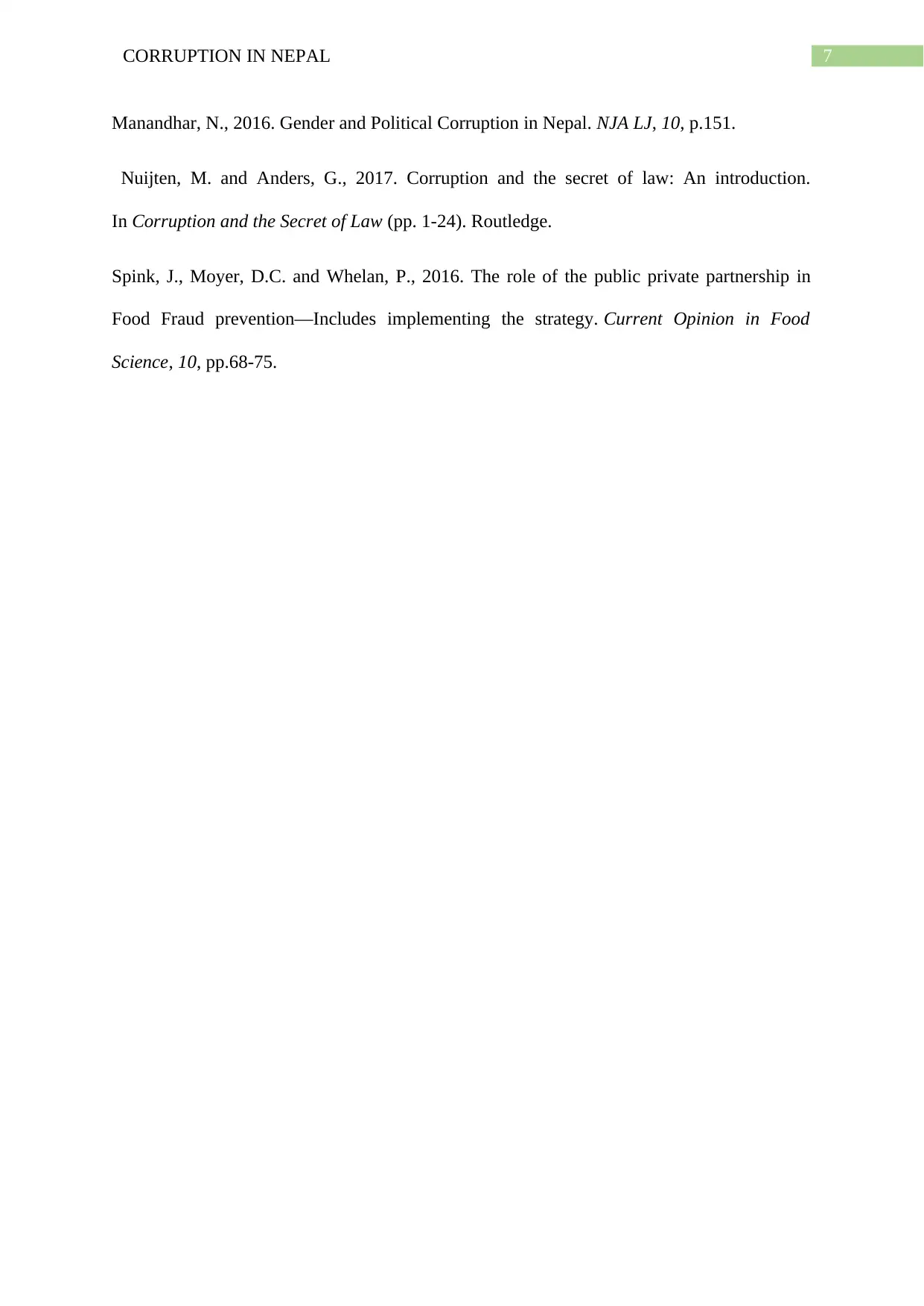
7CORRUPTION IN NEPAL
Manandhar, N., 2016. Gender and Political Corruption in Nepal. NJA LJ, 10, p.151.
Nuijten, M. and Anders, G., 2017. Corruption and the secret of law: An introduction.
In Corruption and the Secret of Law (pp. 1-24). Routledge.
Spink, J., Moyer, D.C. and Whelan, P., 2016. The role of the public private partnership in
Food Fraud prevention—Includes implementing the strategy. Current Opinion in Food
Science, 10, pp.68-75.
Manandhar, N., 2016. Gender and Political Corruption in Nepal. NJA LJ, 10, p.151.
Nuijten, M. and Anders, G., 2017. Corruption and the secret of law: An introduction.
In Corruption and the Secret of Law (pp. 1-24). Routledge.
Spink, J., Moyer, D.C. and Whelan, P., 2016. The role of the public private partnership in
Food Fraud prevention—Includes implementing the strategy. Current Opinion in Food
Science, 10, pp.68-75.
1 out of 8
Related Documents
Your All-in-One AI-Powered Toolkit for Academic Success.
+13062052269
info@desklib.com
Available 24*7 on WhatsApp / Email
![[object Object]](/_next/static/media/star-bottom.7253800d.svg)
Unlock your academic potential
Copyright © 2020–2025 A2Z Services. All Rights Reserved. Developed and managed by ZUCOL.





